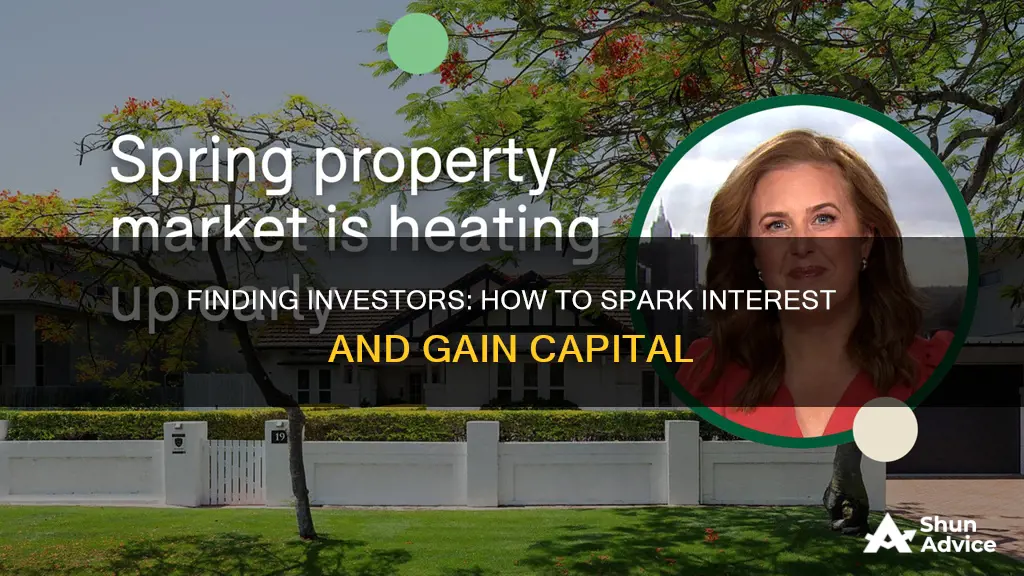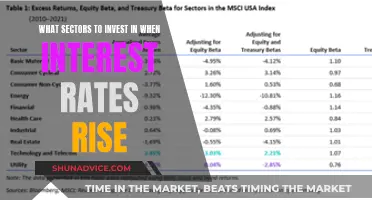
Finding investment interest is a key part of achieving your long-term savings and investment goals. Compounding can help you earn far more than you started with, but it's important to understand the impact of compounding periods and the rate of return on your investment. You can use an investment calculator to see how much your money will grow over time, but you can also calculate this manually.
What You'll Learn

Calculating compound interest
Compound interest is a powerful tool for growing your savings and investments. It is calculated by multiplying the initial principal amount by one plus the annual interest rate raised to the number of compound periods minus one. The formula for calculating compound interest is A=P(1+r/n)^nt, where:
- A = ending amount
- P = original balance
- R = interest rate (as a decimal)
- N = number of times interest is compounded in a specific time frame
- T = time frame
For example, if you invest $1,000 at an annual interest rate of 5% compounded annually, the formula would be A=$1,000(1+0.05/1)^1*1, which equals $1,050. This means that after one year, your investment will be worth $1,050.
The more frequently compound interest is calculated, the greater the growth will be. For example, if you invest $1,000 at an annual interest rate of 5% compounded monthly, the formula would be A=$1,000(1+0.05/12)^12*1, which equals $1,051.27. This means that after one year, your investment will be worth $1,051.27.
Compound interest can also work against you if you have debt. The interest you owe can be compounded, making it increasingly difficult to pay off.
Time to Double Your Money at 10% Interest
You may want to see also

Understanding the Rule of 72
Compounding can help fulfil long-term savings and investment goals, especially if you have time to let it work its magic over years or decades. You can earn far more than what you started with. For example, compound interest is your friend when it comes to savings and investments, as it multiplies your money at an accelerated rate.
The Rule of 72 is a simple formula to estimate how long it will take to double your investment or how long it will take for your money to lose half its value due to inflation. It can also be used to estimate the effect of exponential growth, such as on a savings account with compounded interest (interest added back to the principal at fixed intervals). It can also estimate the effect of exponential decay (like how your money can lose value due to inflation).
The Rule of 72 is an easy way to calculate how long an investment will take to double in value given a fixed annual rate of interest. Dividing 72 by the annual rate of return gives investors an estimate of how many years it will take for the initial investment to duplicate. It is a reasonably accurate estimate, especially at low interest rates. The Rule of 72 is a quick, useful formula that is popularly used to estimate the number of years required to double the invested money at a given annual rate of return.
The Rule of 72 applies to compounded interest rates and is reasonably accurate for interest rates that fall in the range of 6% and 10%. It can be applied to anything that increases exponentially, such as GDP or inflation; it can also indicate the long-term effect of annual fees on an investment's growth.
Cash in Investment Portfolios: Gaining Interest?
You may want to see also

Using an investment calculator
Investment calculators are a great way to find out how much your money can grow over time. They can be used to calculate compound interest, which is interest calculated on both the initial principal and all of the previously accumulated interest. This means that your money can grow at an accelerated rate, as the interest you earn can then earn interest of its own.
To use an investment calculator, you will need to input the following information: the original balance or principal amount, the interest rate (as a decimal), the number of times interest is compounded in a specific time frame, and the time frame. For example, if you are investing £1000 at an interest rate of 5% compounded annually over 10 years, you would input the following information into the calculator: original balance = £1000, interest rate = 0.05, number of times interest is compounded = 1, time frame = 10 years.
The calculator will then use the compound interest formula to calculate the ending amount. The formula for compound interest is A=P(1+r/n)^nt, where A = ending amount, P = original balance, r = interest rate (as a decimal), n = number of times interest is compounded in a specific time frame, and t = time frame. In this example, the ending amount would be £1628.89.
It's important to note that the frequency of compounding can affect the growth of your investment. The higher the number of compounding periods, the larger the effect of compounding. For example, if you compound interest monthly instead of annually, you will see greater compound interest growth. This is because interest is being calculated on a larger amount of previously accumulated interest.
Investment calculators can be a useful tool for planning your financial future and understanding the potential growth of your investments. By inputting different variables, you can see how changes in interest rates, compounding frequency, and time frames can impact your investment returns. This can help you make informed decisions about where and how to invest your money to achieve your financial goals.
How to Keep Your Investment Interests Alive and Well
You may want to see also

How compounding multiplies savings
Compounding multiplies savings at an accelerated rate. This is because compound interest is calculated on both the initial principal and all of the previously accumulated interest. In other words, it's 'interest on interest'. The more frequently interest is compounded, the greater the growth will be. For example, interest can be compounded daily, monthly, quarterly or annually. The higher the number of compounding periods, the larger the effect of compounding.
To calculate compound interest, use the formula A=P(1+r/n)^nt, where: A = ending amount, P = original balance, r = interest rate (as a decimal), n = number of times interest is compounded in a specific time frame, and t = time frame.
You can use a compound interest calculator to work out how much your money will grow. For example, NerdWallet's free retirement calculator. Alternatively, you can calculate it manually using the formula above.
Investment calculator tools can also be used to show how much the money you invest will grow over time. For example, the investment calculator tool on smartasset.com. These tools factor in compounding interest, showing how the interest you earn can then earn interest of its own.
Interest Rates: Impacting Investment Patterns and Decisions
You may want to see also

How compounding multiplies debt
When it comes to debt, compounding can be your enemy. Compounding multiplies debt at an accelerated rate, making it increasingly difficult to pay off. This is because compound interest is calculated on both the initial principal and all of the previously accumulated interest. This interest on interest is known as the power of compound interest.
The higher the number of compounding periods, the larger the effect of compounding. For example, if you have a debt that compounds daily, the interest will be calculated on the initial principal and all of the interest that has accumulated daily. This can quickly add up, especially if the interest rate is high.
The formula for calculating compound interest is A=P(1+r/n)^nt, where: A = ending amount, P = original balance, r = interest rate (as a decimal), n = number of times interest is compounded in a specific time frame, and t = time frame. Using this formula, you can see how compounding can quickly multiply your debt.
To get a better understanding of how compounding can multiply debt, you can use an investment calculator. These calculators allow you to input your initial balance, interest rate, and time frame to see how your debt will grow over time. By playing around with different variables, you can see the impact of compounding on your debt.
Investments: Earning Interest and Growing Your Money
You may want to see also
Frequently asked questions
You can use a compound interest calculator, such as the one provided by NerdWallet, to calculate how much your money will grow. You can also calculate it manually using the formula A=P(1+r/n)^nt, where: A = ending amount, P = original balance, r = interest rate (as a decimal), n = number of times interest is compounded in a specific time frame, and t = time frame.
Compound interest is calculated on both the initial principal and all of the previously accumulated interest. The more frequently interest is compounded, the more it will grow.
You can use an investment calculator, such as the one provided by SmartAsset, to see how much your money will grow over time. You can personalise the results by making additional contributions beyond the initial balance and choosing how often you plan to contribute.







